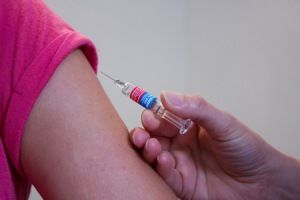News
Low vaccination rate among young people in disadvantaged areas
This article is more than 4 years old.
Every fourth person from the 20-24 bracket has not booked a vaccine time yet – simultaneously fewer are getting their jabs in Tingbjerg, Gellerup and Vollsmose compared to the rest of Denmark.

Some 28 percent of the 20-24 bracket has not booked a vaccination time yet and 40 percent of the 25-29 bracket (photo: dfuhlert)
Over 40 percent of people in Denmark are fully vaccinated – which, when you factor in the ineligible age groups (pre-teens), more or less means half the population.
However, the fast-moving vaccination program could soon encounter a major hurdle on the road to herd immunity: a huge reluctance among people in their 20s to get jabbed.
According to Statens Serum Institut, 28 percent of the 20-24 age bracket have not booked a vaccination time yet – even though invitations were sent in the middle of May.
Similarly, the 25-29 age bracket received their invitations in June and 40 percent have still not booked a time.
Statens Serum Institut: “A pity”
“The status is that everyone has been invited, but the vaccine centres are half empty. And that really is a pity since it’s a good offer we are presenting people,” Henrik Ullum, the CEO of Statens Serum Institut, told TV2.
Ullum wishes to remind people of the many advantages that a vaccine brings.
“To get vaccinated is a very direct way to have a good summer. I think many young people are tired of the final COVID-19 restrictions and want to get back to a normalised society,” he said.
Disadvantaged areas
At the same time, people living in disadvantaged areas are hesitant to book a vaccination time as well. Tingbjerg in Copenhagen has the country’s lowest vaccination rate with 45 percent of all invited people not booking a time.
The same pattern can be seen in Gellerup in Aarhus and Vollsmose in Odense, where 38 and 35 percent respectively haven’t booked their first jab yet.
Different cultures and languages
According to Søren Brostrøm, head of the Sundhedsstyrelsen health authority, a number of reasons could explain the low vaccination rate in disadvantaged areas.
“Some people could be living far from a vaccination centre. Others could live in an area like Tingbjerg, where many different cultures and languages are present,” he said.
“And it might not be everyone who manages to read their eBoks and know how important the vaccination is.”
Pop-up vaccination
Since June, the health authorities have initiated local pop-up vaccine centres in disadvantaged areas that have had a positive effect on the vaccination numbers. Sundhedsstyrelsen plans to expand the offer to more municipalities and continue the initiative after the summer.
The goal is to even out local differences and make sure that anyone who wishes to get a vaccination is offered one.
“The virus is colour-blind. Everyone can get infected and everyone can infect others. The more of us that are vaccinated, the more we’ll be able to protect ourselves and others,” said Brostrøm.
Still one of the highest vaccination rates in Europe
Despite local differences, Denmark still has one of the highest vaccination rates in Europe.
The share of people who have received at least one dose of COVID-19 vaccine in Denmark is 63.32 percent. According to Our World Data, Denmark is only surpassed by Malta at 84.26 percent, Belgium at 65.71 and the Netherlands at 65.26.










































